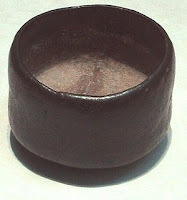 |
| A bowl. Obviously. |
I've said it before and I'll almost certainly say it again: there's no glory to tai chi. Not that I mind. I'm rather keen on that Taoist approach of keeping a low-key approach, like a turtle in the mud, or like water, finding the low places to maintain one's flow. Tai chi chuan is a first -person exercise, not a third person one. The Monkey Army were discussing this point at training this morning, and we've come to the conclusion that the handform simply isn't a spectator sport. It's not meant to be too pretty, nor too exciting. It needs to have an element of functionality about it, which is hard to pin down. In such discussions, inevitably we look towards the rough Zen aesthetic of the Japanese arts, at least before they became over-refined and pastiche-like. A rough ceramic bowl, with glaze dripping unevenly around its topmost edge is something like what we are aiming for with the form: useful, plain, yet beautiful through imperfection (or rather spontaneity) and roughness. Many of the forms that one sees in the tai chi world are over-refined and showy, rather as if one made a huge, impractical bowl from gold with platinum handles and diamond embellishments. Tai chi at this point just becomes another form of athletics or gymnastics, something in which to compete and earn medals and rosettes.
The point is how does it feel? Are we actually doing tai chi? There is a form, and a structure to adhere to. Once we have a handle on that, it's about awareness of breathing, balance and co-ordination. That which we can't feel, we can't use. If we can't feel it in the relatively calm environs of a form class, how will we feel it in more stressful or dangerous situations?
You may say that my form looks bad, and you might be right. But the proof of the pudding is in the feeling, whether feeling the qualities of your own form or feeling another through pushing hands.
This also means that third-person criticism of someone's tai chi after watching their handform makes no sense: so armchair generals beware.
No comments:
Post a Comment